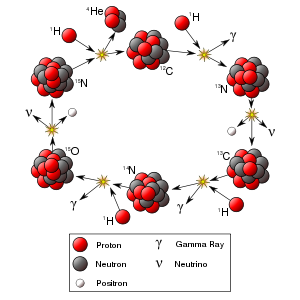Electron capture
| Nuclear physics | ||||||||||||||

| ||||||||||||||
| Radioactive decay Nuclear fission Nuclear fusion
| ||||||||||||||
Electron capture (sometimes called Inverse Beta Decay) is a decay mode for isotopes that will occur when there are too many protons in the nucleus of an atom and insufficient energy to emit a positron. In such a case, a proton in the atomic nucleus captures an inner electron (that is, an electron in an inner shell) and forms a neutron and a neutrino. As a result, the number of protons within the nucleus decreases by one unit and the atom of the "parent" element is transformed into that of another ("daughter") element. The number of nucleons (protons plus neutrons) within the atomic nucleus remains unchanged.
This process leaves the atom of the daughter element in an excited state (higher energy state). When the atom moves to the ground state (lowest energy state), it releases the extra energy in the form of an X-ray photon or an electron (called an Auger electron).
Examples and explanation
If the energy difference between the parent atom and the daughter atom is less than 1.022 mega electronvolt (MeV), positron emission is forbidden and electron capture is the sole decay mode. Consider, for example, rubidium-83, which decays to krypton-83 solely by electron capture. The energy difference between them is about 0.9 MeV.
In this case, one of the electrons in an inner orbital, usually from the K or L electron shell,[1] is captured by a proton in the nucleus, forming a neutron and a neutrino. Since the proton is changed to a neutron, the number of neutrons increases by one, the number of protons decreases by one, and the atomic mass number remains unchanged. By changing the number of protons, electron capture transforms the nuclide of rubidium into a nuclide of krypton. The atom moves into an excited state, with the inner shell missing an electron. When transiting to the ground state, the atom will emit an X-ray photon or Auger electron.
The general process of electron capture can be written as follows:
Additional examples:
For elements around the middle of the periodic table, isotopes that are lighter than stable isotopes of the same element tend to decay through electron capture, while isotopes heavier than the stable ones decay by a process called negative beta decay. A good example of this effect is silver, as its light isotopes use electron capture and the heavier ones decay by negative beta emission.
Inhibition of electron capture
Radioactive isotopes that decay by pure electron capture can, in theory, be inhibited from radioactive decay if they are fully ionized. (The term "stripped" is sometimes used to describe such ions). It is hypothesized that such elements, if formed (by the r-process) in exploding supernovae, are ejected fully ionized and so do not undergo radioactive decay as long as they do not encounter electrons in outer space. Anomalies in elemental distributions are thought to be partly a result of this effect on electron capture.
Notes
- ↑ This type of electron capture is called K-electron capture (K-capture) or L-electron capture (L-capture).
See also
ReferencesISBN links support NWE through referral fees
- Krane, Kenneth S. and David Halliday. Introductory Nuclear Physics. New York: Wiley, 1988. ISBN 047180553X
- Martin, Brian. Nuclear and Particle Physics: An Introduction. Hoboken, NJ: Wiley, 2006. ISBN 0470025328
- Poenaru, D. N. Nuclear Decay Modes. Fundamental and Applied Nuclear Physics Series. Philadelphia: Institute of Physics, 1996. ISBN 0750303387
- Seiden, Abraham. Particle Physics: A Comprehensive Introduction. San Francisco, CA: Addison Wesley, 2004. ISBN 0805387366
- Tipler, Paul and Ralph Llewellyn. Modern Physics. 4th ed. New York, NY: W.H. Freeman, 2002. ISBN 0-7167-4345-0
- Turner, James E. Atoms, Radiation, and Radiation Protection. 2nd ed. New York: Wiley, 1995. ISBN 0471595810
External links
All links retrieved February 13, 2024.
- Electron Capture Jefferson Lab.
| |||||||||||
Credits
New World Encyclopedia writers and editors rewrote and completed the Wikipedia article in accordance with New World Encyclopedia standards. This article abides by terms of the Creative Commons CC-by-sa 3.0 License (CC-by-sa), which may be used and disseminated with proper attribution. Credit is due under the terms of this license that can reference both the New World Encyclopedia contributors and the selfless volunteer contributors of the Wikimedia Foundation. To cite this article click here for a list of acceptable citing formats.The history of earlier contributions by wikipedians is accessible to researchers here:
The history of this article since it was imported to New World Encyclopedia:
Note: Some restrictions may apply to use of individual images which are separately licensed.



